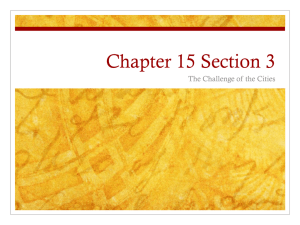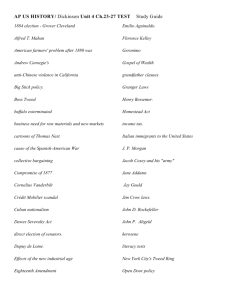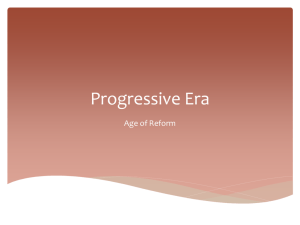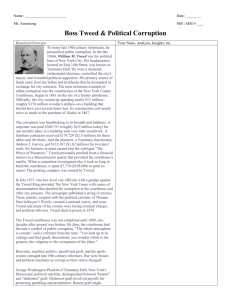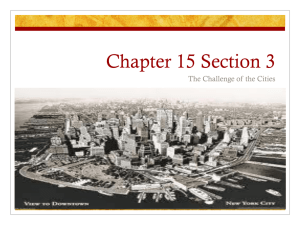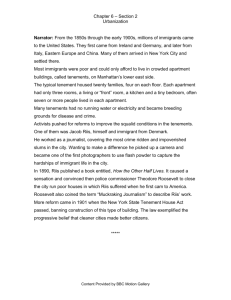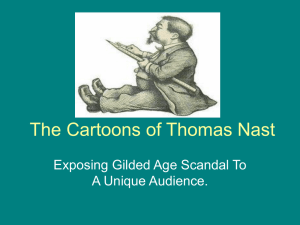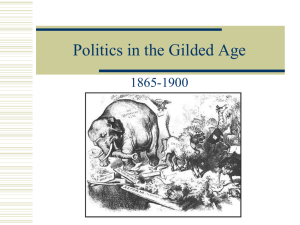Powerpoint
advertisement
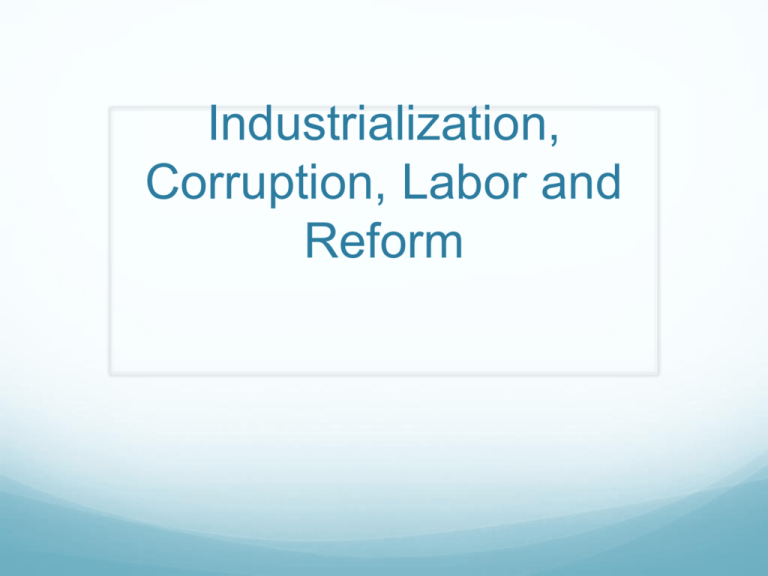
Industrialization, Corruption, Labor and Reform Learnong Objects Understand how art such as Riis’ photography and Nast’s cartoons influenced public policy Analyze how successful was organized labor in improving the position of workers in the period from 1875 to 1900 Identify the economic and political grievances of late 19th century American farmer At the end of the 19th century, the largest worldwide population movement in human history brought a wave of immigrants to the United States. How many came? When did they come? Where did they come from? What types of work were they involved in? (29-31) Describe the shift from home to factory work and from agriculture to industry Describe the shift from self-employment to wage work Describe the shift from water and animal power to fossil fuels Jacob Riis Jacob Riis published How the Other Half Lives: Studies among the Tenements of New York (1890) What technological Innovation allowed Riis to start photographing the slums? What was tenement housing? Tenement Reform Physicians attributed 8,000 to 9,000 deaths a year to tuberculosis, mostly in the poorest and most unsanitary neighborhoods of the City. The First Tenement House Act (1867) required fire escapes for each suite and a window for every room, loophole closed in 1879 by requiring windows to face a source of fresh air and light, not an interior hallway New York State Tenement House Act of 1901 set minimum size requirements for the spaces (such as courtyards) onto which windows opened and mandated that one bathroom be installed inside the building for every two families As House and Garden magazine wrote, "The dumbbell block is perhaps the worst type of tenement ever allowed in a modern, enlightened community. The halls and ten of the fourteen rooms on each floor are dark and ill-ventilated, dependent for light and air solely upon narrow airshafts which give little or no light below the top floors." Business and life What was railroad time? How did management systems change during this period? What is the “business cycle?” What causes it to happen? What are the effects when this cycle is so volatile? Corruption What is the spoils system? Why was it of such concern in terms of corruption? What ended it? Boss Tweed 1860s, William M. Tweed was the political boss of New York City funds came from the bribes and kickbacks that he demanded in exchange for city contract 1861 construction of the New York County Courthouse - the city wound up spending nearly $13 million-roughly $178 million in today's dollars--on a building that should have cost several times less Tweed Corruption A carpenter was paid $360,751 (roughly $4.9 million today) for one month's labor in a building with very little woodwork. A furniture contractor received $179,729 ($2.5 million) for three tables and 40 chairs. And the plasterer, a Tammany functionary, Andrew J. Garvey, got $133,187 ($1.82 million) for two days' work; Tweed personally profited from a financial interest in a Massachusetts quarry that provided the courthouse's marble. When a committee investigated why it took so long to build the courthouse, it spent $7,718 ($105,000) to print its report. The printing company was owned by Tweed. Tweed’s Downfall In July 1871, The New York Times with reams of documentation that the Tweed Ring political cartoons of Thomas Nast in Harper's Weekly, created a national outcry Tweed and many of his cronies were facing criminal charges and political oblivion. The "Brains” 1871 Political Machines Benefits Political machines often created benefits for the city. professionalized urban police forces and instituted the first housing regulations. served the welfare needs of immigrants, offered jobs, food, fuel, and clothing to the new immigrants and the destitute poor. served as a ladder of social mobility for ethnic groups blocked from other means of rising in society. Criticisms In The Shame of the Cities, the muckraking journalist Lincoln Steffens argued that it was greedy businessmen who kept the political machines functioning. It was their hunger for government contracts, franchises, charters, and special privileges, he believed, that corrupted urban politics. What was the problem with the Sherman Anti-Trust Act and the Interstate Commerce Act? Labor What made the CLU unique compared to previous unions? Describe the Knights of Labor? How was the Knights of Labor “racist?” Describe the story of the “Eight-Hour Movement.” Labor What happened at Haymarket Square in Chicago? Describe what transpired at Homestead between 1889-1892. How did this demonstrate that “locally organized workers were ill-matched against new, nationally organized corporations Agrarian Revolt and Populism What were the economic concerns of the rural working class? What is the Farmer’s Alliance? What is Populism? What are the platforms of the new Populist Party? What was the “free silver movement”? Populism Readings Identify the economic and political grievances of late 19th century American farmers. How compelling do you find the farmers' reform program? Do you think that agrarian radicalism was a realistic response to actual conditions or an irrational and hysterical expression of farmers' fears and anxieties? Was the decision of farmers in l896 to focus on the issue of free silver a betrayal of agrarian ideals or a reasonable response to the political situation facing farmers? Make a chart showing the similarities and difference amount the Populist, Democrat and Republican Platforms Election of 1896
